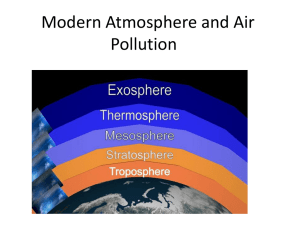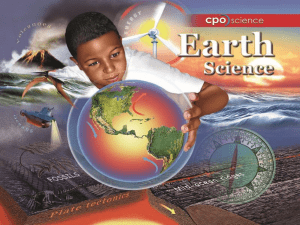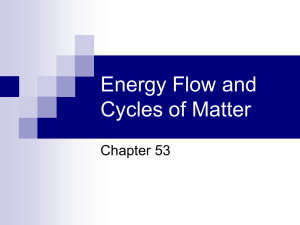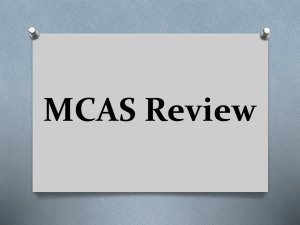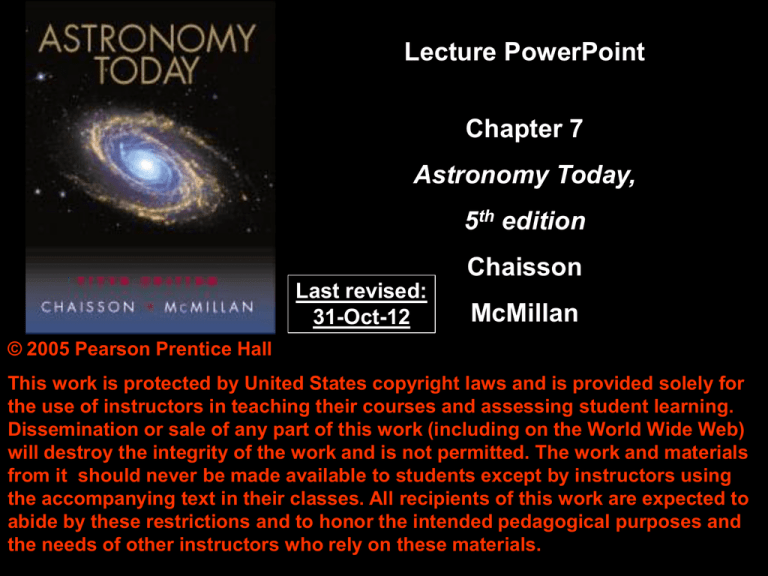
Lecture PowerPoint
Chapter 7
Astronomy Today,
5th edition
Chaisson
Last revised:
31-Oct-12
McMillan
© 2005 Pearson Prentice Hall
This work is protected by United States copyright laws and is provided solely for
the use of instructors in teaching their courses and assessing student learning.
Dissemination or sale of any part of this work (including on the World Wide Web)
will destroy the integrity of the work and is not permitted. The work and materials
from it should never be made available to students except by instructors using
the accompanying text in their classes. All recipients of this work are expected to
abide by these restrictions and to honor the intended pedagogical purposes and
the needs of other instructors who rely on these materials.
Chapter 7
Earth
Units of Chapter 7
Overall Structure of Planet Earth
Earth’s Atmosphere
Why Is the Sky Blue? Rayleigh scattering
The Greenhouse Effect and Global Warming
Earth’s Interior
Earth’s “Rapidly” Spinning Core
Units of Chapter 7, cont.
Surface Activity
Earthquakes - seismology
Radioactive Dating - ages of rocks
Earth’s Magnetosphere
Van Allen Belts
The Tides
7.1 Overall Structure of Planet Earth
•Differentiated into
layers
•Mantle: upper & lower
• Two-part core: inner
(solid) & outer (liquid)
• Thin crust:
lithosphere &
asthenosphere
• Hydrosphere
(oceans)
• Atmosphere:
stratified into layers
7.2 Earth’s Atmosphere
x-rays
γ-rays
• The blue curve
shows the
temperature
at each altitude
• Troposphere is
where convection
takes place –
responsible for
weather
•Ozone layer in
the top of
stratosphere
UV
O2→ 2O*
O*+ O2→O3
Ionosphere is ionized by solar radiation (x-ray
& γ-ray, and is a good conductor; this is
where the aurorae are occurring
Reflects radio waves in the AM range (short
wave/ham radio), but transparent to FM and
TV (satellite TV)
7.2 Earth’s Atmosphere (more detailed)
Ozone layer is in the upper stratosphere;
absorbs ultraviolet radiation
Chlorofluorcarbon molecules (CFCs) destroy
ozone layer (ozone “hole”) by interfering with
the ozone cycle
Ozone Conc.
Montreal Protocol (1987,1990,1992): limit
production and use of CFCs
The Nobel Prize in Chemistry 1995:
… for their work in atmospheric chemistry,
concerning the formation and decomposition
of ozone"
Sherwood
Rowland
Mario
Molina
Paul
Crutzen
This is why our air conditioners and aerosol cans had
to have their coolants changed. China, India and
others still do not follow the protocol!
7.2 Earth’s Atmosphere
Convection depends on warming of
ground by the Sun:
7.2 Earth’s Atmosphere
Surface Heating:
• Sunlight that is not reflected is
absorbed by Earth’s surface, warming it
• Surface reradiates as infrared thermal
radiation
• Atmosphere absorbs some infrared,
causing further heating
7.2 Earth’s Atmosphere
This is known as the
greenhouse effect:
Molecules absorb IR
energy and heat the
atmosphere
Main absorbers: CO2,
H2O, CH4, CFCs,
hydrocarbons
Kyoto Protocol limits
on greenhouse gas
emissions
Atmosphere scatters blue, but not red, light,
making the sky appear blue.
This is called Rayleigh scattering.
Lord Rayleigh
(1842-1919)
1904 Nobel Prize
Int. 1/λ4
so shorter λ
scatters
more
The Carbon Cycle
Important Greenhouse Gases
Gas
1998 Level / Increase since 1750 / Radiative forcing (Wm-2) (J kg-1)
Carbon dioxide (CO2)
365 ppm 87 ppm 1.46 0.819
Carbon Monoxide (CO)
11.1 ppm 46 ppb 0.89 1.013
Methane Marsh gas (CH4) 1,745 ppb 1,045 ppb 0.48 2.191
Nitrous oxide (N2O)
314 ppb 44 ppb 0.15 0.88
“Laughing gas”
Tetrafluoromethane (CF4)
80 ppt 40 ppt 0.003 1.33
Hexafluoroethane (C2F6)
3 ppt
3 ppt 0.001 0.067
Sulfur hexafluoride (SF6)
4.2 ppt 4.2 ppt 0.002 0.074
HFC-23* (CHF3)
Trifluoromethane
HFC-134a* (C2H2F4)
1,1,1,2-tetrafluoroethane
HFC-152a* (C2H4F2)
1,1-Difluoroethane
14 ppt
14 ppt 0.002 0.064
7.5 ppt
7.5 ppt 0.001 0.007
0.5ppt
0.5ppt 0.000 0.04
7.2 Evolution of Earth’s Atmosphere
History of Earth’s atmosphere:
• Primary atmosphere was hydrogen, helium;
this escaped Earth’s gravity
• Secondary atmosphere, from volcanic
activity, mostly nitrogen
• Life appeared, creating atmospheric
oxygen
Geology
Geological
Ages
(click for
enlargement)
Ages of the Earth and Sun
• In the 19th century Kelvin and Helmholtz thought
they had explained how the Sun worked to
Lord Kelvin
produce its energy: gravitational contraction
energy.
• Gravitational potential energy of infalling gas
became kinetic energy and heated up the Sun
• This process gave a lifetime for the Sun of up to
25 million years. They thought they had solved
the problem!
Hermann
Helmholtz
Ages of the Earth and Sun
• Geologists and paleontologists throw a big monkey
wrenches into the works when they start to study
river canyons and start finding dinosaur bones.
• John Wesley Powell explores the Grand Canyon in
1869 & 1871 and finds it must be at least 2 billion
years old!
Emma Dean
Powell
Ages of the Earth and Sun
Layers of geologic
history
230-280 mya
300 mya
350 mya
475 mya
500-570 mya
1000 mya
Grand Canyon
1,900 mya
Types of Rocks
Igneous: crystalline solids which form directly
from the cooling of magma
Given names based upon two things: composition
(what they are made of) and texture (how big the
crystals are).
Two types:
Intrusive (solidify below surface)
exs: diorite, granite, gabbro. pegmatite
Extrusive (solidify above surface)
exs: basalt, andesite, obsidian, pumice,
rhyolite
Intrusive rocks
Granite
Pegmatite
Diorite
Gabbro
Extrusive rocks
Basalt
Pumice
Andesite
Obsidian
• Sedimentary: called secondary,
because they are often the result of the
accumulation of small pieces broken
off of pre-existing rocks
• Three types: Clastic, Chemical and
Organic
Sedimentary rocks
Breccia
Limestone
Iron ore (hematite)
Sandstone
• Metamorphic: name from "meta"
(change) and "morph" (form)
• Common metamorphic rocks include
slate, schist, gneiss, and marble.
Metamorphic rocks
Marble
Slate
Schist
Quartzite
7.3 Earth’s Interior
Seismic waves:
• Earthquakes produce both pressure (P) and
shear (S) waves
• Pressure waves will travel through both
liquids and solids
• Shear waves will not travel through liquid, as
liquids do not resist shear forces
• Wave speed depends on density of material
7.3 Earth’s Interior
Can use pattern of reflections during earthquakes
to deduce interior structure of Earth:
Both p and s-waves
go through solid
parts
Only p-waves go
through liquid
parts
Waves are refracted
Can use this to
triangulate epicenter of
quakes
Seismology
p-waves
compression waves
s-waves
transverse waves
7.3 Earth’s Interior
Currently accepted model:
7.3 Earth’s Interior
Mantle is much less dense than core
Mantle is rocky; core is metallic – iron and
nickel
Outer core is liquid; inner core is solid, due
to pressure
Volcanic lava comes from mantle, allows
analysis of composition
Plate Tectonics
• Alfred Wegener (1880-1930)
Proposed the idea of continental
drift in 1915
• It was accepted only after
enough observational evidence
from magnetic, fossil, geological
and other fields was amassed after the 1950s!
7.4 Surface Activity
Continental drift: Entire Earth’s surface is covered
with crustal plates, which can move independently
Earthquakes and volcanoes occur at plate
boundaries:
“Ring of Fire” Around Pacific Plate
7.4 Surface Activity
Earth’s upper mantle, near a plate boundary; this is
a subduction zone, where one plate slides below
another:
7.4 Surface Activity
A plate colliding with another can also raise
it, resulting in very high mountains:
Himalayas
Asian
plate
Indian Plate
Plates can also slide along each other, creating
faults where many earthquakes occur:
San Andreas Fault
North
American
Plate
Pacific plate
7.4 Surface Activity
Finally, plates can move away from each other,
creating rifts. Exs.: mid-Atlantic ridge and East
African rift
Paleomagnetism
The new crust created at rift
zones preserves the
magnetic field present at the
time it solidified
From this we can tell that
magnetic field reversals
occur about every 500,000
years:
Harry Hess
3D Topographic Map
7.4 Surface Activity
Plate motion is driven by convection
currents in the mantle material:
If we follow the continental drift backwards in
time, the continents were one supercontinent.
It is called Pangaea:
Laurasia
Gondwana
Tethys
Sea
Oceanography
• Science founded by a Tennessean
from Franklin:
Matthew Fontaine Maury
• Published “The Physical Geography
of the Oceans” the first book of
oceanography
• Called the “Pathfinder of the Seas”
• Mapped all the ocean currents around
the world
• Also a founder of meteorology:
started US weather reports for
farmers
• Founder of US Naval Observatory and
the timekeeping service still used
today
• Instrumental in getting the US Naval Academy in
Annapolis founded
• One of the main buildings there is Maury Hall
• Most decorated American scientist
• Discovered many comets
Michelson
• Made first stellar atlas by
an American
Maury
• His bust in Capitol Rotunda
in Nashville and portrait on
state library ceiling
Only non-martial
original monument
on Monument
Avenue of
Richmond, VA
Ocean Currents
Maury’s maps took 45 days off NY to San Francisco trips!
Many of his medals came from other countries to honor his
discoveries. Large economic impact as well.
Clouds
Hurricanes & Tornados
WHY?
Katrina
Combination of winds and
Earth’s rotation (Coriolis
effect)
Gustav
Coriolis
Violent collision of high and
low pressure fronts
Atmospheric Circulation
Ferrel cell
7.5 Earth’s Magnetosphere
The magnetosphere is the region around the Earth
where charged particles from the solar wind are
trapped:
These charged particles are trapped in areas
called the Van Allen belts, where they spiral
around the magnetic field lines:
Van Allen Belts
31-Jan-1958
James Van Allen
Explorer I ; 1st US satellite
Near the poles, the Van Allen belts
intersect the atmosphere. The charged
particles spiral the magnetic field lines
(synchrotron radiation);
when they do, they create glowing
light called an aurora:
From the ground
From the Space Shuttle
7.6 The Tides
Tides are due to gravitational force on Earth from
Moon – force on near side of Earth is greater than
force on far side (diffferential forces). Water can
flow freely in response.
•The water bulges are
always aligned towards
the Moon
•Moon takes a month to
move around the Earth
•The solid Earth rotates
every 24 hrs.
•So tides occur about
every 6 hours at a given
place on the Earth
The Sun has less effect, but it does modify the
lunar tides
Spring tides (higher)
Earth Sun and Moon
in a straight line
Neap tides (lower)
Earth, Sun and Moon
make a right angle
Tides tend to exert a “drag” force on the Earth,
slowing its rotation (Tidal friction). Our day gets
longer as the Moon recedes from us. [Every 100
million years our day gets 1 hour longer]
This will continue until the Earth rotates
synchronously with the Moon, so that the same
side of the Earth always points toward the Moon.
Tides
Differential forces
Tidal friction
Bay of Fundy
Nova Scotia
There are many places in the world that are now using
tidal power like this to generate electricity
Summary of Chapter 7
• Earth’s structure, from inside out:
Core, mantle, crust, hydrosphere,
atmosphere, magnetosphere
• Atmosphere is mostly nitrogen and oxygen;
thins rapidly with increasing altitude
• Greenhouse effect keeps Earth warmer than it
would otherwise be
• Study interior by studying seismic waves
• Crust is made of plates that move
independently
Summary of Chapter 7, cont.
• Movement at plate boundaries can cause
earthquakes, volcanic activity, mountain ranges,
and rifts
• New crust formed at rifts shows evidence of
magnetic field reversals
• Earth’s magnetic field traps charged particles
from solar wind
• Tides are caused by gravitational effects of
Moon and Sun




